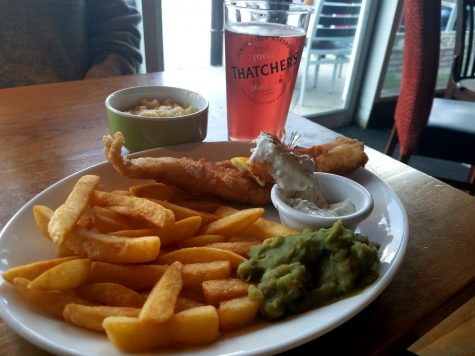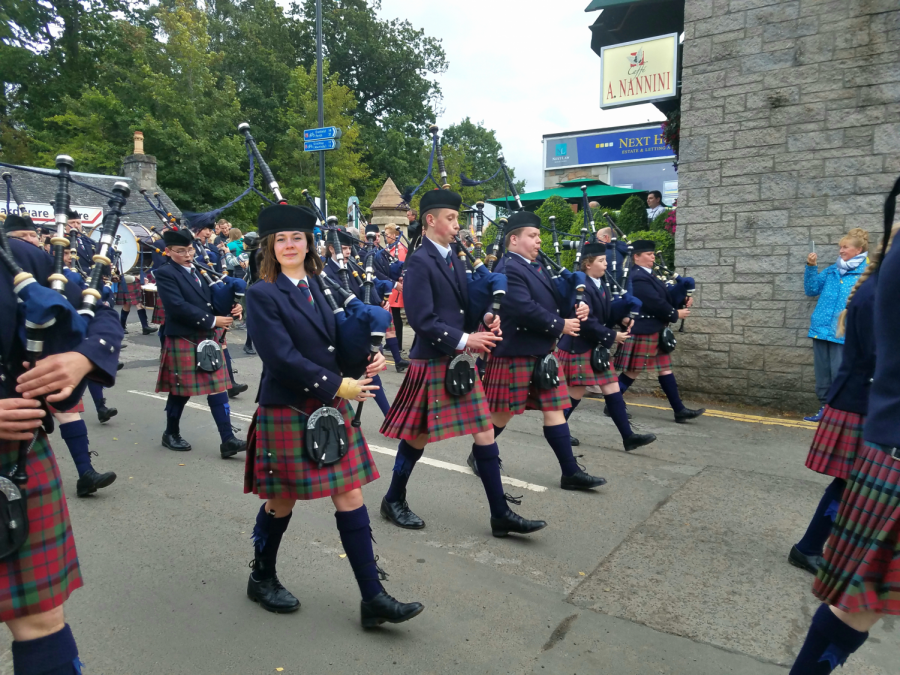In the land of bagpipes and haggis: an NVU student’s introduction to Scotland
I am startled awake by the friendly “bing!” of the airplane’s seatbelt sign as we start our descent in the smallest plane I’ve ever been on. The turbulence begins, and I look out the window just as we duck into the troposphere and become immersed in a sea of clouds. A wave of anticipation and excitement washes over me as I wait to see my home for the next three and a half months spread out below me.
And in a minute or so, there it was. The landscape reminds me of a quilt with all its little patches of farmland, relatively flat, but with huge, flat-topped mountains that seem to come out of nowhere. Up ahead is the beautiful city of Edinburgh, Scotland.
And thus began my study abroad experience.
I am here on exchange for the semester at Napier University, where I will be studying and experiencing (for the first time) what the UK and Europe in general have to offer. What better way to learn about a new culture than to throw yourself right into it right?
The grocery store was one of my first journeys that led to culture shock.
I had found the milk and the cheese in this little-yet-packed grocery store, but the eggs were nowhere to be found. Maybe they are near the meat section? I maneuver my basket, which rolls on the ground behind me, or drags and nearly tips when I go around a corner. Still no eggs.
I have now abandoned the dream of making an omelette tomorrow morning, and proceed to the baking/ biscuits isle to see what I can find for a morning snack. I grab some traditional Scottish biscuits and make my way to the checkout line.
But behold! Two whole shelves filled with eggs sitting right at the end of the isle, next to the flour and sugar. Not a refrigerator in sight!
The UK has different regulations and rules for certain foods than the US, including not washing eggs. They can do this because eggs have a natural and protective layer of bacteria called a “bloom” or “cuticle.” The eggs can stay good for up to two and a half weeks on the counter this way, but if you’re like me, they will all be gone by then anyway.
The US seems to have a phobia of unwashed eggs, as all must be washed in order to be sold. This is largely because the commercial egg industry is so unsettling in the US that they get exposed to vile conditions and pathogens that would make not washing them out of the question.
I grew up eating unwashed eggs from my own chickens, so this appealed to me.
Come to find out, a lot of food in the UK goes bad much quicker because they also have stricter regulations on preservatives.
This led to another culture shock for me: in general, people do several smaller shopping trips through the week rather than bulking up every so often with $100 worth of food.
That’s why a lot of grocery stores are so small in the city. Of course, there are larger, more supermarket sized places to get your food, but the average size of a grocery store is a little larger than a Maplefields, but with more shelves. And the employees get to sit down while working the register, so their legs don’t fall off by the end of the day.

Fish, chips and “mash” from McCowen’s
After my trip to the store, I decided that I was too jetlagged to actually prepare any of the food I had bought, so I went out to eat.
Most restaurants and bars, as I’ve come to find out, are seat yourself and get up to order type deals. Someone might greet you on the way in, but you have to go up to the bar or counter to order anything.
It’s a nice concept, because sometimes you know exactly what you want when you walk in, and with this system, you get the ball rolling right away. However, if you are not used to it, you look foolish sitting at the table for 10 or 15 minutes, looking confused.
My first meal was fish and chips from a place across the street from my apartment, or “flat” called McCowans. I figured I would test out a classic, and fish is a big culinary staple since the UK is a big island. The fish seemed and was more fresh than I was used to, and the fried batter on the outside was not atrociously thick like I would expect from America. It was the perfect ratio of lightly salted batter to fish, and paired well with the creamy and bright, freshly mixed tartar sauce.
The fries, I mean “chips,” were unsalted, which apparently is also very common. This also made me happy because now I could salt to my comfort level and enjoy the crispy-on-the-outside-soft-on-the-inside slices of potato heaven.
The dish also came with “mash” which my American upbringing told me would be more potatoes and I got very excited. But then I remembered that somewhere in my YouTube crash course culture lesson I had put myself through before I arrived that “mash” actually is mashed up peas. Other places refer to them as “mushy peas,” so, if I didn’t feel like I was eating baby food before, I sure did then.
The waiter recommended that I try the “brown sauce” on them. Now, I am not too sure how to describe brown sauce other than it tastes pretty much like brown vinegar with a thicker consistency. The one I tried was made by good ol’ Heinz, and was, well, not my favorite thing in the world, despite being a fan of fries and vinegar.
However, I’ve heard that some places make their own, so I’m optimistic that there’s still a chance for me.
Of course, I had to try the famous Scottish food haggis. I tried it two different ways and had two different reactions.
Now, to clarify, I am pescatarian, so I did not (and will not) try the real thing. If you ask a local what haggis actually is, they get this cheeky smile on their face and they just say, “If I explain it to you, you won’t want to eat it, but you should try it,” then quickly change the subject.
But I was intrigued.
Traditionally, haggis is made from the “sheep’s pluck” (A.K.A the heart, liver and lungs) with minced onion, oatmeal, suet, spices and stock, and encased (like a sausage) in the animal’s stomach. Typically the casings are artificial now, but many people don’t really care given the “ick factor” of the rest of the dish.
One popular way to prepare it is wrapped in a pastry, and that is how I got mine from a vendor at the Grass Market . This would be my first taste of the dish.
The outside is flakey, buttery and soft and warm to the touch. It smells like a good, hearty sausage. The light pastry falls apart as you bite and crunches ever so slightly. Then you get to the haggis, which mushes like nasty, overly seasoned playdough into your mouth, clogging your airway and sticking like peanut butter to every surface.
Cayenne pepper, black pepper and salt is all I know for a few seconds, like a punch in the face until it evened out.
Needless to say, I was not a big fan, but I figured I would try other versions because really the texture and the overly powerful spices were the biggest turn off for me.
The next time I tried it was with a breakfast I got from a restaurant/pub called The Fountain. The breakfast included toast, two fried eggs, two roasted tomatoes, a small pile of boiled spinach, two mushroom tops, two patties of veggie haggis, a veggie sausage, a hand full of “potato puffs,” which are pretty much tater tots, and a small side of baked beans. This all came to a total of £8 ($9.92) and was exactly what I needed in my life.
In small quantities, paired up with eggs, beans, mushrooms or spinach, the haggis was a lovely dash of flavor, not too strong, with a disguisable texture.
The meal itself was remarkable, minus the veggie sausage, which I found to be a little dry.
Another Scottish staple I had heard about and was excited to see everywhere I went was Irn Brew. It’s a soft drink that reminds me of a mixture of that disgusting orange Dayquil that you gag after doing that two-tablespoon shot of, and cream soda. Some of my friends who have tried it compare it to cheap bubblegum or Fanta.
You wouldn’t expect those flavors to be any good together, or even on their own sometimes, but it is surprisingly refreshing and I rather enjoyed it. I definitely recommend giving it a try if you ever get a chance. It is also, as I have heard from the locals, supposedly the best cure for a hangover. I personally will not be testing this theory, but I will try to gather some more information and report back.
I was surprised by the popularity of the drinking culture, even though I knew it was going to be more extreme than in America. In fact, the first week of school is dedicated to settling in and partying. Students could get wristbands for £35 that got them into all the club parties through the week and gave discounts on drinks.

A castle in Edinburgh
The drinking age in most of Europe is 18, so a lot of the time you see kids that look like they could be 12 running around the club, experiencing their first taste of the night scene. It can get a little bit awkward, but from what I can tell people tend to drink more responsibly and there are fewer accidents.
I don’t really drink, but I went to a couple of the clubs to try it out.
A lot of the music that is played are real throwbacks to the ‘90’s and 00’s, which is kind of cool. Even when you go out to restaurants or pubs, the majority of the music came out before 2010. Everyone seems to just appreciate the classics, but it feels a little bit like you’re back in time by a decade or so, especially with the popular fashion being ‘80’s and ‘90’s based.
I was slightly off put when the “Cotton Eye Joe” came on and no one got into lines to do the dance that had been drilled into my as well as my fellow American peers’ heads since Elementary School. They just kept dancing the way they had been and I looked like a fool.
This scene appealed more to me than what I’ve experienced in America. Not that I’ve experienced much.
I also have to adapt to the local slang, and try to blend in. I have found that the moment I open my mouth, people want to know where I’m from. Whether it’s from my wicked cool New Hampshire/ Vermont accent, or my own slang, people are quick to ask the question. I have a tendency to say “I gotchu,” and when I was at the Pitlochry Highland Games, someone remarked, “I gotchu? Where are you from?”
One of the most popular things they say is “cheers” which they use as a gesture of thanks or gratitude. I have started saying, “Thank you, cheers,” as I slowly morph into a local.

Sophomore, Journalism
Grew up in Salisbury, NH
Fall 2018 - Present
The closest I have come to fame so far is once, at a Weird Al concert, he went...






